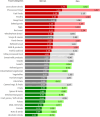Sex-specific dietary habits and their association with weight change in healthy adults
- PMID: 39501340
- PMCID: PMC11539530
- DOI: 10.1186/s12916-024-03730-3
Sex-specific dietary habits and their association with weight change in healthy adults
Abstract
Background: Dietary intake plays a pivotal role in the prevalence and management of obesity. While women and men exhibit differences in dietary habits and food-related behaviors, sex-based weight loss recommendations are lacking. This study aims to examine the impact of specific foods and food categories on weight reduction in men and women over a two-year period.
Methods: A total of 8,548 participants from the 10K cohort, from 2019 to 2023, were included in the analysis (53.1% women, mean age 51.7 years). Anthropometric measurements and laboratory results were collected at baseline and at the two-year follow-up visit. Dietary assessment was based on daily food intake digitally logged through an application for at least 3 consecutive days at both timepoints. We compared intake of macronutrients, micronutrients, food groups and daily energy consumption between sex and body mass index (BMI) categories at baseline and weight change categories at follow-up. Using linear regression, we assessed the associations between food categories or specific foods and BMI at baseline as well as weight change percentage at follow-up.
Results: Dietary habits varied by BMI and sex. Women and men living with obesity (BMI > 30 kg/m2) reported a greater intake of animal-based protein and lower intake of plant-based proteins and fats at baseline, as compared to participants with normal weight. In linear regression models predicting two-year weight change, including age, income, and baseline weight, the explained variance was 5.6% for men and 5.8% for women. Adding food categories and specific foods increased the explained variance to 20.6% for men and 17.5% for women. Weight reduction in men was linked to daily consumption of an egg (1.2% decrease) and beef (1.5% decrease), while in women, the most pronounced reductions were associated with an apple (1.2% decrease) and cashew nuts (3.4% decrease). Notably, total energy intake changes significantly impacted weight outcomes only in women.
Conclusions: Sex-specific dietary habits significantly influence weight change over time. In men, weight loss was primarily associated with the addition of animal-based protein, while in women, it was linked to caloric deficit and plant-based fat, suggesting that sex-based nutritional interventions may demonstrate greater efficacy.
Trial registration: NCT05817734 (retrospectively registered January 31, 2023).
Keywords: Body mass index; Diet; Nutritional epidemiology; Personalized nutrition; Sex; Weight loss.
© 2024. The Author(s).
Conflict of interest statement
E.S. is a paid consultant for Pheno.AI. The other authors declare no competing interests.
Figures




References
-
- Tiwari A, Balasundaram P. Public Health Considerations Regarding Obesity. In: StatPearls. 2024. https://www.ncbi.nlm.nih.gov/books/NBK572122. Accessed 01 Aug 2024. - PubMed
-
- Karam G, Agarwal A, Sadeghirad B, Jalink M, Hitchcock CL, Ge L, et al. Comparison of seven popular structured dietary programmes and risk of mortality and major cardiovascular events in patients at increased cardiovascular risk: systematic review and network meta-analysis. BMJ. 2023;380:e072003. - PMC - PubMed
-
- Friedrich MJ. Global obesity epidemic worsening. JAMA. 2017;318(7):603. - PubMed
-
- Gregg EW, Shaw JE. Global health effects of overweight and obesity. N Engl J Med. 2017;377(1):80–1. - PubMed
Publication types
MeSH terms
Associated data
LinkOut - more resources
Full Text Sources
Medical

